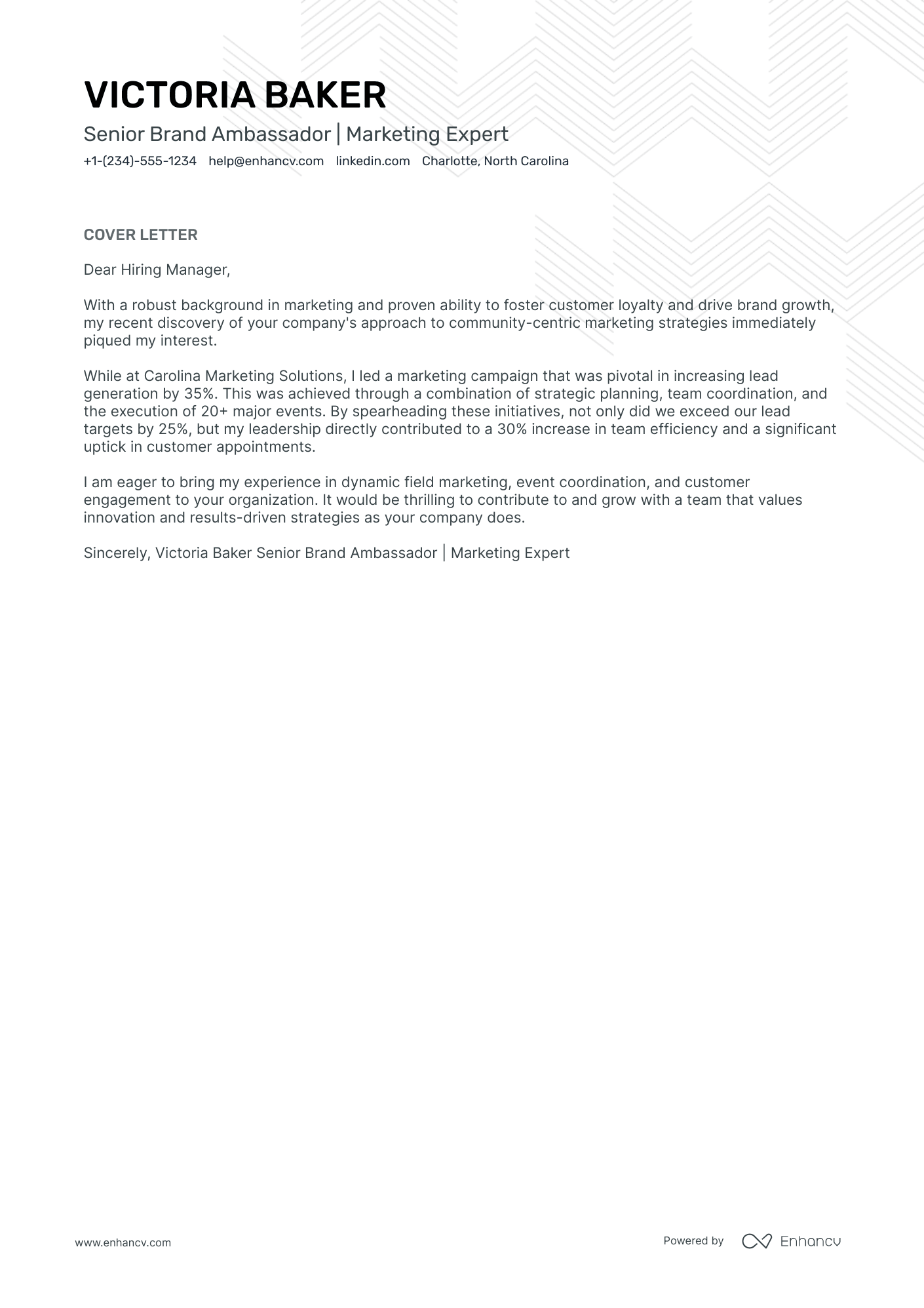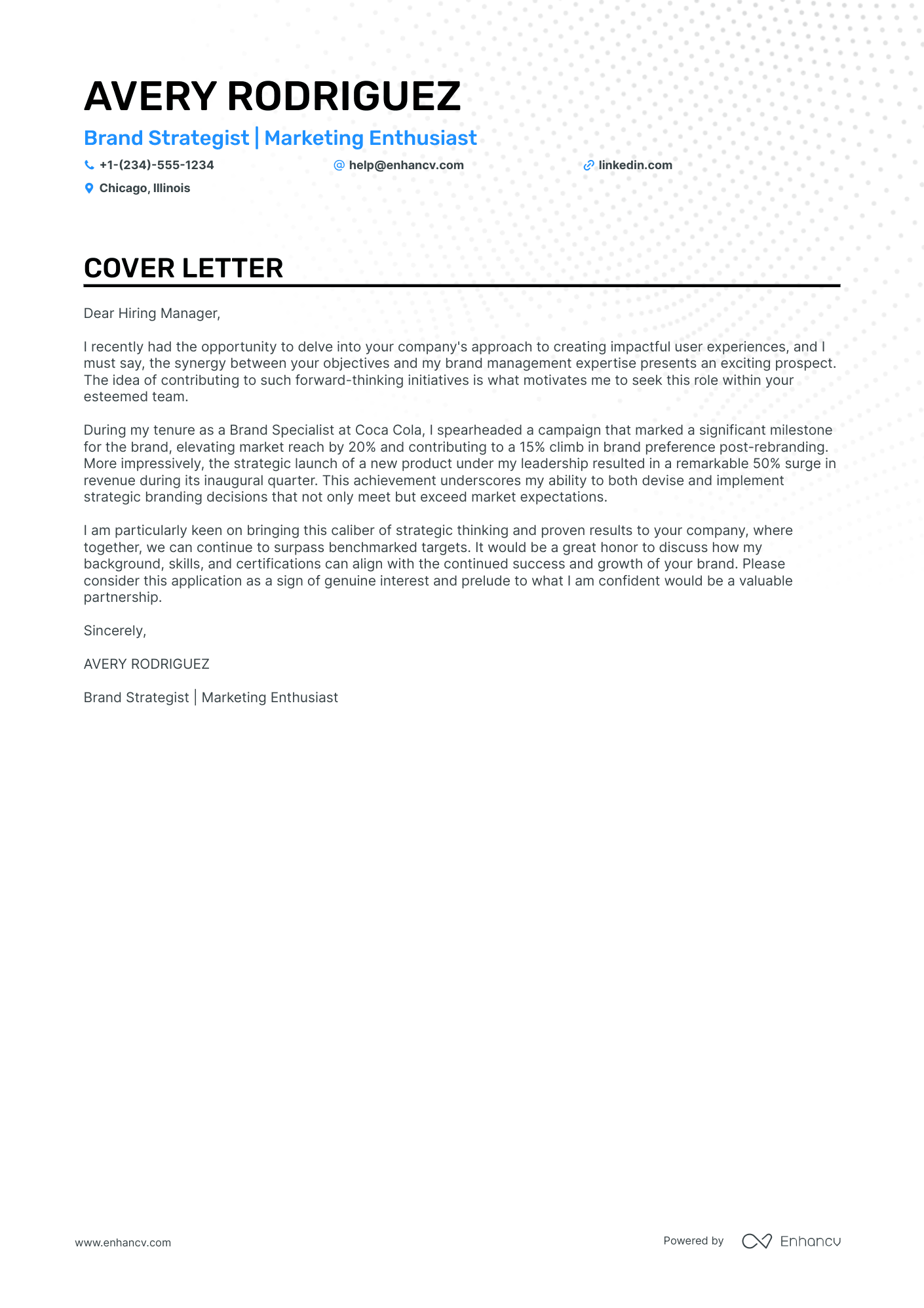Embarking on your journey as a brand ambassador, you've meticulously filled out your application and polished your resume, but you've hit a stumbling block: the cover letter. Unlike a resume, your cover letter is your chance to highlight a significant professional triumph without echoing what’s already been said. It should be a compelling, cliché-free narrative that stays within one page. Unlock the secrets of crafting a cover letter that encapsulates your proudest achievement and captivates your potential employer.
- Including all the must-have paragraphs in your structure for an excellent first impression;
- Learning how to write individual sections from industry-leading cover letter examples;
- Selecting the best accomplishment to tell an interesting and authority-building professional story;
- Introducing your profile with personality, while meeting industry standards.
And, if you want to save some time, drag and drop your brand ambassador resume into Enhancv's AI, which will assess your profile and write your job-winning cover letter for you.
If the brand ambassador isn't exactly the one you're looking for we have a plethora of cover letter examples for jobs like this one:
- Brand Ambassador resume guide and example
- Digital Marketing Specialist cover letter example
- Sales And Marketing cover letter example
- Web Content Manager cover letter example
- Social Media Specialist cover letter example
- Digital Marketing cover letter example
- Senior Marketing Manager cover letter example
- VP Marketing cover letter example
- Public Relations Manager cover letter example
- Engagement Manager cover letter example
- Content Editor cover letter example
Drop your resume here or choose a file.
PDF & DOCX only. Max 2MB file size.
Brand ambassador cover letter example
Isabella Adams
Chicago, Illinois
+1-(234)-555-1234
help@enhancv.com
- Highlighting quantifiable achievements, such as increasing brand awareness by 25% and climbing sales by 15%, immediately showcases the candidate's ability to drive results and contribute to business growth.
- Emphasizing experience in managing large teams and developing comprehensive marketing strategies demonstrates leadership capabilities and strategic thinking, traits that are valuable for a marketing coordinator role.
- Mentioning the alignment of previous projects with corporate objectives and market demands illustrates the candidate’s understanding of business operations and their ability to tailor marketing initiatives to meet those needs.
- Expressing admiration for the company’s innovative campaigns and desire to contribute to its continued success helps to personalize the cover letter, showing that the candidate has done their research and is genuinely interested in the company’s mission and vision.
What about your brand ambassador cover letter format: organizing and structuring your information
Here is one secret you should know about your brand ambassador cover letter assessment. The Applicant Tracker System (or ATS) won't analyze your cover letter.
You should thus focus on making an excellent impression on recruiters by writing consistent:
- Header
- Greeting
- Introduction
- Body paragraphs (and explanation)
- Promise or Call to action
- Signature (that's optional)
Now, let's talk about the design of your brand ambassador cover letter.
Ensure all of your paragraphs are single-spaced and have a one-inch margins on all sides (like in our cover letter templates).
Also, our cover letter builder automatically takes care of the format and comes along with some of the most popular (and modern) fonts like Volkhov, Chivo, and Bitter.
Speaking of fonts, professionals advise you to keep your brand ambassador cover letter and resume in the same typography and avoid the over-used Arial or Times New Roman.
When wondering whether you should submit your brand ambassador cover letter in Doc or PDF, select the second, as PDF keeps all of your information and design consistent.
Don’t stress about writing your cover letter. Use our free cover letter generator to make one in seconds.
The top sections on a brand ambassador cover letter
- Header: Include your contact information, the date, and the employer’s details to ensure the letter is professional and easy for the recruiter to reference.
- Greeting: Address the letter to a specific person if possible, as personalized greetings are more engaging and show that you have done your research about the company.
- Introduction: Briefly mention your enthusiasm for the brand and the ambassador role, as well as any personal connection you have to the product, which can be a strong persuasive element.
- Body: Detail your relevant experience and skills, including any previous ambassador roles or promotional work, and emphasize your ability to effectively represent and promote the brand's image and values.
- Closing: Reassert your excitement for the opportunity, include a call to action such as requesting an interview, and thank the reader for considering your application, which leaves a positive, proactive impression.
Key qualities recruiters search for in a candidate’s cover letter
- Demonstrated passion for the brand: Exhibiting genuine enthusiasm and belief in the company's mission and products is essential, as a brand ambassador's primary role is to embody and promote the brand's values and lifestyle.
- Strong communication skills: Being able to articulate the brand's message clearly and engagingly across various platforms and to different audiences is critical to effective promotion and generating interest.
- Social media presence and influence: A robust online following and the ability to influence public opinion positively are highly valued, as much of a brand ambassador's impact is through social media engagement and content creation.
- Previous promotional experience: Practical experience with marketing campaigns, product demonstrations, or promotional events can indicate a capacity to effectively represent and advocate for the brand.
- Networking abilities: A knack for connecting with others, building relationships, and leveraging social networks is vital to expanding the brand's reach and acquiring new customers or clients.
- Consistency and reliability: Demonstrating a consistent personal brand that aligns with the company's image, along with a track record of reliability, assures recruiters of the ambassador's commitment and potential for long-term partnership.
How to personalize your brand ambassador cover letter greeting
Before you start writing your brand ambassador cover letter, take the time to find out who is recruiting for the role.
Search for the recruiter's name on LinkedIn or the corporate website to address them personally in your brand ambassador cover letter salutation.
What if you can't find out who's recruiting for the role?
Always aim to avoid the very impersonal "Dear Sir/Madam" - instead, opt out for "Dear HR Team" or "Dear Hiring Manager" to make a better first impression.
List of salutations you can use
- Dear Hiring Manager,
- Dear [Company Name] Team,
- Dear [Department Name] Hiring Committee,
- Dear [Mr./Ms./Dr. Last Name],
- Dear [Job Title] Search Committee,
- Dear [First Name Last Name],
First introductions in your brand ambassador cover letter
Within your brand ambassador cover letter introduction, genuinely state what you like about the organization.
Research the latest company projects, honorary awards, company updates, etc.
Write up to two sentences to let recruiters know what impresses you about the company,
This would help you to set a good tone for the rest of the communication.
That one achievement in your brand ambassador cover letter body
The lengthiest part of your brand ambassador cover letter is the body.
Within the next three to six middle paragraphs, present yourself as the best candidate for the role.
How can you do that without retelling your whole professional resume?
Select one key achievement that covers job-crucial skills and technologies (and is memorable).
Within the body of your brand ambassador cover letter, aim to tell the story of how you achieved your success. Also, write about how this would help out your potential team.
Time to wrap up your brand ambassador cover letter
Writing the closing paragraph of your brand ambassador cover letter is just as important as the salutation.
You have to make it personalized to the job advert and recruiter.
Experienced professionals advise candidates to end with a request or reminder for follow-up. Write that you're grateful for the opportunity, and, at the same time, hint that you're available for the next steps of the process.
Otherwise, you could also conclude your brand ambassador cover letter by facing the future. How do you see yourself, as part of the team? In particular, how would you settle in your new role in the first six months to a year?
The zero experience brand ambassador cover letter: shifting the focus to your unique value
Don't worry if you have no conventional professional experience. Within your whole experience, there's plenty more you can write about in your brand ambassador cover letter.
Take, for example, your biggest achievement or award - dedicate your cover letter body to describe it and the job-relevant skills you've learned.
Your professional ambitions could also take center stage. Describe what you plan on achieving in the next five to ten years and the efforts you're making towards your dreams.
Key takeaways
Winning recruiters over shouldn't be difficult if you use your brand ambassador cover letter to tell a story that:
- Is personalized by greeting your readers and focusing on key job skills greets;
- Isn't spread all over the place, but instead focuses on one key achievement and selling your value as a professional;
- Introduces your enthusiasm for the role, passion for the job, or creativity in communication;
- Is also visually appealing - meeting the best HR practices;
- Ends with a nod to the future and how you envision your growth, as part of the company.
Brand Ambassador cover letter examples
By Experience
Entry-Level Brand Ambassador
Senior Brand Ambassador
By Role













